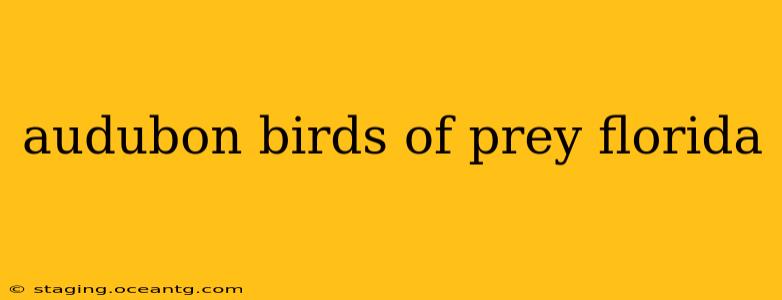Florida's diverse ecosystems provide a rich habitat for a variety of birds of prey, and the Audubon Society plays a crucial role in their conservation and study. This guide delves into the raptors you might encounter in the Sunshine State, their habitats, and the conservation efforts underway to protect them.
What Birds of Prey are in Florida?
Florida boasts a fascinating array of birds of prey, ranging from the majestic Bald Eagle to the smaller, but equally impressive, American Kestrel. Some of the most common raptors found throughout the state include:
- Bald Eagle ( Haliaeetus leucocephalus): Florida's state bird, the Bald Eagle is a powerful symbol of the state and a testament to successful conservation efforts. They thrive in coastal areas, inland lakes, and rivers.
- Osprey (Pandion haliaetus): These fish-eating specialists are frequently seen near bodies of water, perched on pilings, utility poles, or trees, watching for their next meal.
- Red-shouldered Hawk (Buteo lineatus): A common sight in wooded areas, these hawks are easily identified by the reddish-brown shoulders that give them their name.
- Red-tailed Hawk (Buteo jamaicensis): One of the most widespread hawks in North America, the Red-tailed Hawk is a versatile hunter found in various habitats across Florida.
- Northern Harrier (Circus hudsonius): These graceful hawks are often seen soaring low over marshes and grasslands, hunting rodents and other small prey.
- American Kestrel (Falco sparverius): The smallest falcon in North America, the American Kestrel is a colorful and agile hunter, found in open fields and woodlands.
- Peregrine Falcon (Falco peregrinus): Known for their incredible speed, Peregrine Falcons are powerful hunters that can be found along Florida's coastlines and in some inland areas.
Where Can I See Birds of Prey in Florida?
Observing birds of prey in their natural habitat is a rewarding experience. Several locations in Florida offer excellent opportunities for birdwatching:
- Audubon Corkscrew Swamp Sanctuary: This sanctuary provides a haven for many bird species, including various raptors.
- Lake Okeechobee: The vast expanse of Lake Okeechobee offers excellent opportunities for observing Bald Eagles, Ospreys, and other water-loving birds of prey.
- Everglades National Park: The Everglades ecosystem supports a diverse range of raptors, including the elusive Snail Kite.
- Various State Parks and Wildlife Management Areas: Many state parks and wildlife areas across Florida offer excellent birdwatching opportunities. Check local guides for specific locations and timing.
What is the Audubon Society's Role in Protecting Florida Birds of Prey?
The Audubon Society plays a vital role in the conservation of Florida's birds of prey through various initiatives, including:
- Habitat preservation and restoration: Audubon works to protect and restore crucial habitats for these birds, ensuring they have the necessary resources to thrive.
- Research and monitoring: Audubon conducts research to understand the population dynamics and conservation needs of Florida's birds of prey.
- Educational programs: Through educational outreach, Audubon raises awareness about the importance of raptor conservation and encourages responsible birdwatching practices.
- Citizen science initiatives: Audubon engages citizen scientists in monitoring programs, expanding their research capabilities and fostering community involvement.
What Threats Do Birds of Prey Face in Florida?
Like many wildlife species, Florida's birds of prey face several threats:
- Habitat loss and fragmentation: Development, agriculture, and urbanization continue to reduce and fragment crucial habitats for these birds.
- Pesticide exposure: Pesticides can accumulate in the food chain, negatively affecting the health and reproductive success of birds of prey.
- Lead poisoning: Ingestion of lead shot from hunting can lead to lead poisoning in birds of prey.
- Collisions with power lines and vehicles: These collisions can cause serious injuries or fatalities.
How Can I Help Protect Florida Birds of Prey?
You can contribute to the conservation of Florida's birds of prey by:
- Supporting conservation organizations: Donate to or volunteer with organizations like the Audubon Society.
- Practicing responsible birdwatching: Maintain a safe distance from nesting sites and avoid disturbing birds.
- Reducing your pesticide use: Opt for environmentally friendly pest control methods.
- Supporting sustainable land use practices: Advocate for responsible development that minimizes habitat destruction.
- Educate others about the importance of raptor conservation.
By understanding the challenges faced by Florida's birds of prey and taking proactive steps to support their conservation, we can ensure that these magnificent creatures continue to soar over the Sunshine State for generations to come. The Audubon Society's dedication, combined with the efforts of individuals and communities, is essential for securing a future where these magnificent birds thrive.
